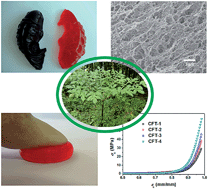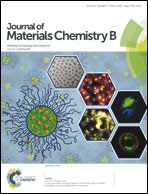A novel biocompatible double network hydrogel consisting of konjac glucomannan with high mechanical strength and ability to be freely shaped†
Abstract
A novel physically linked double-network (DN) hydrogel based on natural polymer konjac glucomannan (KGM) and synthetic polymer polyacrylamide (PAAm) has been successfully developed. Polyvinyl alcohol (PVA) was used as a macro-crosslinker to prepare the PVA–KGM first network hydrogel by a cycle freezing and thawing method for the first time. Subsequent introduction of a secondary PAAm network resulted in super-tough DN hydrogels. The resulting PVA–KGM/PAAm DN hydrogels exhibited unique ability to be freely shaped, cell adhesion properties and excellent mechanical properties, which do not fracture upon loading up to 65 MPa and a strain above 0.98. The mechanical strength and microstructure of the DN hydrogels were investigated as functions of acrylamide (AAm) content and freezing and thawing times. A unique embedded micro-network structure was observed in the PVA–KGM/PAAm DN gels and accounted for the significant improvement in toughness. The fracture mechanism is discussed based on the yielding behaviour of these physically linked hydrogels.


 Please wait while we load your content...
Please wait while we load your content...